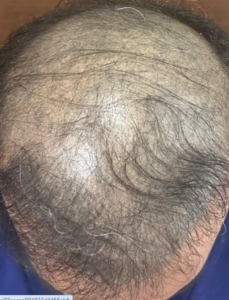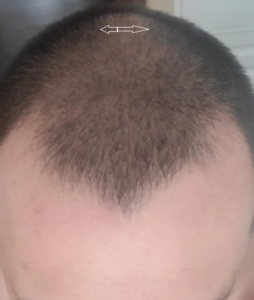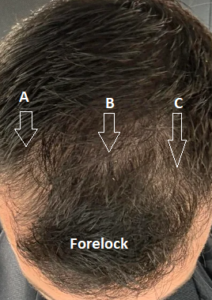I noticed recently that biden was ALL bald at the top (sorry for my lack of proper terminology to describe this situation) when he was competing for nomination in the 1980s. But now – come on – he has thinned but at least there are hairs on top. any ideas?
In 2014 – was 24 years old in between a Norwood III and IV, and underwent a FUE 2700 grafts to mainly cover the front. Didn’t start fin as was apprehensive of the side effects but started minoxidil which I was also inconsistent with over the years. In more recent years (last 5-6 years have been taking Nourkrin man as a supplement and topical Min 5% foam very consistently) In 2016 underwent SMP in London.
The balding area grew as my native hair started falling, while the transplanted hair also got thinner. Used to manage a nice look with the help of hair fibres over the last many years which did wonders. Finally in Feb 2024 (age 34) decided to pull the plug on another HT. Consulted with 3-4 top surgeons and mostly their feedback was consistent with c 2500 grafts available from donor area and another 600-800 from the beard. The clinic I went with managed to extract 2700 from the scalp and 800 from the beard area over 2 days. Total c 3500 grafts. They reconstructed the hairline (one thin line ahead of the earlier transplant area) and temple area along with filling up the midscalp region and sparsely covering the back scalp (the crown was mostly left untouched given the large balding area). I though you wanted to see the views on the work done in terms of look one day post implantation / distance between graft placement? I also realised my mistake of not starting fin (more mature now!) – hence have started 1mg a day and hopefully that along with min helps some regrowth along with the new HT to hopefully give a good result! Your thought please?
When you start the hair transplant process before the age of 26, you are looking at more hair transplants because the native hair and your balding pattern may advance with age, as happened in your case. I am surprised that more hair from the hair transplant hasn’t lasted the past 10 years. We see those on occasion; however, this is not that common. Most of my hair transplant patients keep their transplanted hair for a very long time. I have been doing hair transplants for the past 33 years, and some of the men I transplanted in 1992-3 have since visited me with hair on their heads. It is important to note that this man’s donor supply was significantly reduced. SMP is a good procedure, but as you can see from this man’s before picture, the SMP has faded and developed a blue tint. In addition, the individual dots from the SMP have spread out and are no longer little dots. This is common with SMP.
The average man has about 5000-7000 grafts, provided their hair is not fine. If their hair is coarse and their density is at least average, the donor area can supply 8000, possibly more, grafts. Fine hair does not produce much bulk, so donor site depletion is common in fine-haired individuals especially with FUE. For those reading this post, the message is to be sure to ask your surgeon to discuss your original donor density, hair mass, and total donor supply for your lifetime before undergoing a hair transplant. The distribution of the grafts was appropriate, with more density up front; however, considering the extent of the transplants I see, I wonder how this man’s donor supply will look in terms of over-harvesting.
I’m one of the countless who have started taking Dut and trying to figure out the best way to transition off of Finasteride to Dut daily. It seems that doctors and users do not agree on this topic. Some have suggested, and it seems in theory, that taking a loading phase of Dut is the best route since it takes 3 months of 0.5mg to reach steady state serum levels and possibly more at the tissue level. My current routine went from 1mg Fin to 0.5mg finasteride daily and 0.5mg Dutasteride daily. In theory, I’d do this for 3 months to not cause a shed from a medication gap, switch cold turkey, minimize simultaneous new medication shed, and stop fin shed. Since Fin binds to androgen receptors at the tissue level (scalp), and if finasteride is already binding to it all before dutasteride is introduced, does that prevent dutasteride from being able to bind to those receptors? And is it probably better to discontinue Fin and just keep doing dutasteride? People have great results when adding dutasteride 1x or 2x a week, which sounds counterproductive. In theory, thought would still leave Duta to block type 1 receptors, but fin still blocking type 2? I’ve seen, admittedly, just a few horror stories when people go up to 3x a week while using finasteride. They get better results once they go all in on one or the other. As much as I researched this, I’m still ignorant of how these drugs work at this level since most talk about its DHT blocking is usually blood /serum DHT and not at the scalp/tissue level.
First, you’ll need the doctor to evaluate your donor area to rule out any disease that may be there. Assuming that you are over 25, the pattern looks like you are going to a Class 5A pattern. I would need to see your hair under trichoscopy to determine that, but it means that more balding is likely to occur on a limited basis in your upper crown areas. Good doctors routinely perform trichoscopy to rule out diseases of the donor area and the metrics that I am about to discuss. It would be best to have metrics for your lifetime donor supply, including (1) donor density and (2) hair shaft thickness of the donor hairs. This will tell the surgeon what you will look like after the hair transplant, which will be shared with you. Then, a good surgeon will complete the examination by judging where your balding pattern will end up. Good planning is critical so you only expend some of your donor hair on a limited vision of where you are now. Balding is progressive, and you want to be sure that in the long term, you will always look normal and have enough hair left to follow the progressive nature of YOUR balding.
Hi! I was stupid and stopped fin for a couple of month due to travelling at that point my hair was great and after I realized what I had done, I went immediately back of 0.5mfs every other day but my hair went absolutely bad and shedded for two more months. I’m devastated right now.
When you get benefits from finasteride, you must remember that the drug and your stabilized hair loss go hand in hand. Stopping finasteride causes “Catch-up Hair Loss” which means that when you stop the finasteride, you not only go back to where you were when you started taking it, but you lose what you would have lost had you not taken it in the first place. Please, if you are on finasteride and you are not having problems with the drug, stay on it.
Some men have strong forelocks; when they start balding, as this man shows, you see the forelocks remain strong. The balding occurs around the forelock (A, B, C). A man with a strong forelock often doesn’t look like they are balding because the forelock holds the frame to the face. When I transplant balding in a patient with the pattern shown below, I leave the forelock alone, realizing that sometimes, as this man grows older, he may lose the forelock, and then he will need it transplanted; however, in my experience, when men have strong forelocks to the age of 35, they are more prone to keep these forelock, regardless of the balding that may occur over time further back in the head. These forelocks, I believe, have a genetic code different from the surrounding hair.
Any idea if ursolic acid can help with male-pattern hair loss? In the study below, it says it reduced DHT.
Ursolic acid appears to be an interesting possible treatment for a variety of conditions including an enlarged prostate, inflammatory diseases and some cancers however it is not approved for clinical use. Although it is easy to extrapolate its effects on prostate hypertrophy and its relationship to hair loss, there is no proof that this has value nor that it is safe for the treatment of hair loss.
21 y/o, been on fin for 3 months now and am seeing some new strands around the temples I think, but as the recession is already so big I wonder if it will be enough in my case. But topical min is ofc rather inconvenient (is it even sustainable long term..?), and oral min is not available where I live.
What do you think – is it worth giving fin alone a couple of more months or is it unrealistic to get this amount of regrowth with fin? After summer I will move to a new city so I definitely want to look better by then.
I have seen men who lost hair regain their hair on finasteride alone. They are usually under 24 years of age and they looked like they never were balding.
I’ve heard mixed things on this. Some doctors have said that it can cause micro-scarring and make the scalp not viable for a transplant. If that’s the case I might want to stop. Generally I do like 1mm dermastamp once weekly.
Microneedling done at a 1.25mgg depth doesn’t go deep enough to cause significant scarring. On average, the hair follicle goes down to a depth of between 5-7 mm, so the growth of the hair follicle in the dermis is unobstructed by any scarring.
I unable to find 1Mg finasteride and there is only 5Mg available in my country .. what to do please help??
This is not uncommon. I advise people to cut the pill into 4 or 5 equal parts. Most people find that the pill will crumble so apportion the amount that you take. It is important to know that what counts is not the daily dosage but the weekly dosage divided into seven days.
Hey all, I am soon going to start using topical minoxidil. The only brand (Linn Minoxidil) I could get a hold of somewhat easily where I live (the Netherlands) is a spray. The manual says to spray six times on the balding spot. But I am a norwood 3.5-4, and hence would like to spray both on my diffusing crown and receded temples. The manual however does not specify how to treat multiple areas, i.e do I just do three sprays on the temple and three sprays on the crown? Or do I have to use the spray on i.e the crown alone? Was wondering if anyone here has faced this issue/knows the answer.
First, you must be aware that only 40 % of men will respond to the topical minoxidil. On the other hand, the oral form is 100% effective because it is metabolized in the liver into its active form. I generally prefer to agree with the manufacturing instructions; however, with the topical minoxidil that I am familiar with, one good application a day works well. I recommend applying it after a hot shower on a damp scalp to increase absorption. If you do not get a good response to the topical, you may assume that you are one of the 60 % of men who do not respond to the topical form. If you are committed to going the minoxidil route, the oral form requires a prescription. I have seen wonderful results from oral minoxidil.
When you bleed with microneedling, it shows you are at the correct depth. From a numbers perspective, I recommend a 1.25 mm depth. I particularly like the “Dr Pen” device because you can hold it over each area and deliver an effective injury to induce the healing cascade. Once per week is adequate; more frequent use is unnecessary. The photograph shows that you are using it where you want your hairline to return. I can see that clearly by the bleeding that shows in the photo.
I have a question regarding the mechanism of action behind androgenetic alopecia. I see some people saying that we lose hair as males with pattern hair loss because the scalp hairs are more sensitive to DHT in the area of balding (pattern). I also read that some people say that the conversion from test to DHT (via. 5AR) is greater in the scalp tissue than in other body parts. This begs the question: why would you ever need to block DHT in the whole body by using oral meds like fin and dut If the “problematic” test conversion happens in the scalp tissue, then topical dut/fin or a topical anti-androgen should be enough ? Anything I am missing something? Thank you!
Hair loss occurs in males because we carry the genes for hair loss, and our DHT hormones trigger hair loss. The genes are programmed to determine when hair loss starts, but most men get it before age 26. I have seen men develop hair loss as late as in their early 50s, but this is an exception to the rule. If we decided to cut off your testicles, I doubt that you would have hair loss, but that is an extreme approach to reduce the impact of DHT. Topical finasteride goes through the skin and into your body as it gets absorbed through the skin/scalp. You might as well take the oral finasteride. There is a type of liposomal topical finasteride where most of it stays in the scalp, but this is expensive and only covers part of the scalp. If you spread it around the scalp, it raises the cost considerably.
I’m cautious of the microneedling + Minoxidil success stories here only because it might be the case that they were strong responders to Minoxidil irrespective of the microneedling. I’m more interested in those who added microneedling to the protocol after some time on Minoxidil/min+fin alone. Anyone with some post history or experiences?
Microneedling will work by itself without minoxidil.
I have been applying minox foam to my pubic hair for the past 3 months. My pubic hair was quite long to begin with, but now the hairs are over 4 inches long. Typically they would be only at 2-3 inches at the longest. I was doing this experiment to see if it would make sense to use pubic hair in a hair transplant and my research has lead me to believe minox is a valid solution to the length issue when using pubic hair for scalp hair transplant. I will continue to apply once a day, 1 ml for the foreseeable future (wife is not happy)
Pubic hair has been used for hair transplants in the past. The problem is its very curly nature and it may not match your hair characteristics.





